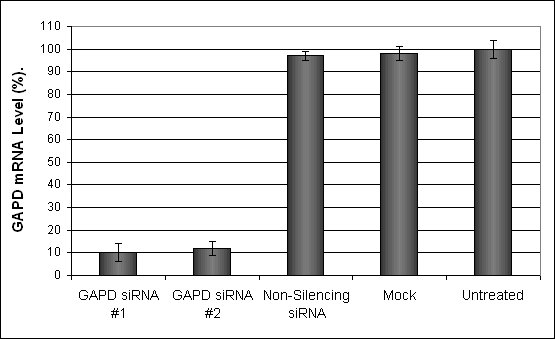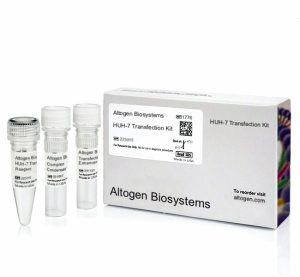Description
Purchase Orders: Click “Add to Cart” button to order, then email PO to orders@altogen.com.
Product Availability: In Stock.
Transfection Reagent for HUH-7 Cells (Liver Cancer Cells)
- A biodegradable polymer based transfection reagent – once inside the cell, the polymer degrades into smaller less toxic components reducing cell toxicity, facilitating release of the transgene, and improving transfection efficiency
-
Optimized for intracellular delivery of plasmid DNA, siRNA, microRNA, and mRNA
-
High transfection efficiency of both siRNA and plasmid DNA without compromising cell viability
-
Gentle enough to be used for single cell analysis
-
Download in vitro Huh7 transfection protocol: [PDF]
- Download Huh7 CRISPR/Cas9 transfection protocol: [PDF]
-
Download PowerPoint presentation for Huh7 cells transfection kit: [PPT]
- UPC/GTIN/EAN: 860002089776
-
Brand: ALTOGEN®, developed and manufactured by Altogen Biosystems
Transfection Efficiency:
Reagent exhibits at least 88% transfection efficiency of siRNA delivery. Transfection efficiency was determined by qRT-PCR.
Product Description:
Optimized transfection kit for high transfection efficiency of Huh7 cell line derived from human hepatocellular carcinoma. Used in molecular biology to facilitate the introduction of foreign nucleic acids (DNA and RNA) into Huh7 cells. Compatible with DNA and RNA transfection.
Transfection Protocol and SDS:
Download Altogen Biosystems Huh-7 Transfection Protocol: [PDF]
Download SDS: [PDF]
HUH-7 Cell Line:
Huh7 is a human hepatoma cell line that was originally derived from a hepatocellular carcinoma (HCC) in a patient with hepatitis C virus infection. It is widely used in liver cancer research as a model system to study various aspects of HCC biology, including cell proliferation, apoptosis, migration, invasion, and drug resistance. According to the American Cancer Society, liver cancer has a much better prognosis for complete remission and survival, if diagnosed early. Furthermore, liver cancer caught early has a 50% 5-year survival rate, versus an only 3% survival rate if it is detected late and has spread to other organs. The HuH-7 hepatoma cell line consists of well-differentiated tumorigenic liver cells that are useful for carrying out transfection studies. The HuH-7 cell line was derived from a liver tumor of a 57-year-old Japanese male patient in 1982. HuH-7 is a type of immortal cell line, as hepatoma cells, they exhibit an epithelial cell morphology. In addition to being a suitable transfection host for multiple cellular and molecular biology applications, this cell line is extensively employed in liver cancer research. Common forms of liver cancer are usually caused by viral hepatitis (B or C) infection or cirrhosis. Altogen Biosystems offers polymer-based biodegradable transfection reagents for the HuH-7 hepatoma cell line.
Mutations:
| TP53 | 7157 | 37 | 17 | 7578190 | 7578190 | Missense_Mutation | SNP | T | C |
| OR8I2 | 120586 | 37 | 11 | 55861122 | 55861122 | Missense_Mutation | SNP | C | A |
| MTIF2 | 4528 | 37 | 2 | 55464459 | 55464459 | Missense_Mutation | SNP | A | C |
| FER | 2241 | 37 | 5 | 108516519 | 108516519 | Missense_Mutation | SNP | G | T |
| GPR115 | 221393 | 37 | 6 | 47682279 | 47682279 | Missense_Mutation | SNP | C | T |
| OR4C6 | 219432 | 37 | 11 | 55432843 | 55432843 | Missense_Mutation | SNP | G | T |
| USP28 | 57646 | 37 | 11 | 113704162 | 113704162 | Nonsense_Mutation | SNP | G | A |
| OBSCN | 84033 | 37 | 1 | 228522866 | 228522866 | Silent | SNP | C | T |
| CD300E | 342510 | 37 | 17 | 72613294 | 72613294 | Silent | SNP | G | A |
| CPSF3L | 54973 | 37 | 1 | 1255859 | 1255859 | Silent | SNP | G | A |
Data:

Figure 1. GAPD mRNA levels were quantified using real-time RT-PCR in the Huh-7 cells transfected with siRNAs targeting GAPD or non-silencing siRNA. Forty-eight hours post-transfection, the cells were harvested and analyzed by real-time RT-PCR for GAPD mRNA expression levels. Data were normalized against the 18S rRNA signal. Control samples were either mock-transfected or untreated. Values are normalized to untreated sample. Data are means ± SD (n=5).

Figure 2. Protein expression of GAPDH in HUH-7 cells. DNA plasmid expressing GAPDH or siRNA targeting GAPDH were transfected into HUH-7 cells following Altogen Biosystems transfection protocol. At 72 hours post-transfection the cells were analyzed by Western Blot for protein expression levels (normalized by total protein, 10 µg of total protein loaded per each well). Untreated cells used as a negative control.
Altogen Biosystems is a life sciences company that offers cell type-specific and pre-optimized transfection products, elecroporation kits, and in vivo delivery reagents. Advanced formulation of reagents and optimized transfection protocols provide efficient intracellular delivery of protein, DNA, mRNA, shRNA and siRNA molecules. Read more about transfection technology at Altogen’s Transfection Resource. Altogen Labs provides safety and efficacy preclinical research services. GLP-compliant studies for IND applications, and drug development, including over 90 in-house validated xenograft models, safety toxicology, etc (visit AltogenLabs.com).
Volume Options:
- 0.5 ml (Catalog #1775)
- 1.5 ml (Catalog #1776)
- 1.5 ml CRISPR (Catalog #2158)
- 8.0 ml (Catalog #1777)
Purchase Orders: Click “Add to Cart” button to order, then email PO to orders@altogen.com.
Product Availability: In Stock.






